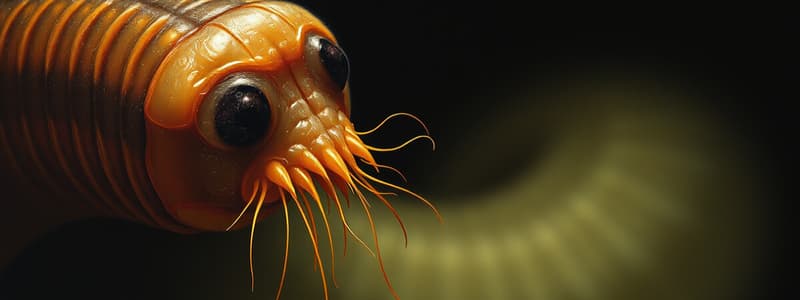Podcast
Questions and Answers
What is a cuticle?
What is a cuticle?
Non-cellular tough body covering
What are amphids?
What are amphids?
Circular concentration sensory organs located at anterior of organism
What is ecdysis?
What is ecdysis?
Shedding periodically 'Molting'
What are phasmids?
What are phasmids?
What is the hypodermis?
What is the hypodermis?
What are copulatory spicules?
What are copulatory spicules?
What is hydrostatic pressure?
What is hydrostatic pressure?
What is an alimentary canal?
What is an alimentary canal?
Describe Phylum Nematoda's classification as Eumetazoan, Triploblastic, etc.
Describe Phylum Nematoda's classification as Eumetazoan, Triploblastic, etc.
List basic characteristics of Phylum Nematoda.
List basic characteristics of Phylum Nematoda.
What is the epidermis's role regarding the cuticle?
What is the epidermis's role regarding the cuticle?
What hormone promotes ecdysis?
What hormone promotes ecdysis?
Nematodes have a hydrostatic skeleton.
Nematodes have a hydrostatic skeleton.
How do nematodes accomplish internal fertilization?
How do nematodes accomplish internal fertilization?
Match the nematodes with their characteristics:
Match the nematodes with their characteristics:
Are nematodes monoecious or dioecious?
Are nematodes monoecious or dioecious?
Nematodes are described as ______.
Nematodes are described as ______.
What two ways can body-wall muscles in nematodes contract?
What two ways can body-wall muscles in nematodes contract?
What is the structure of a nematode's digestive system?
What is the structure of a nematode's digestive system?
Where is the fluid held in a nematode's hydrostatic skeleton?
Where is the fluid held in a nematode's hydrostatic skeleton?
Flashcards are hidden until you start studying
Study Notes
Cuticle and Body Structure
- Cuticle is a non-cellular, tough body covering, secreted by the epidermis.
- Hypodermis is the cellular layer beneath the cuticle that produces it.
- Nematodes have a pseudocoelom filled with fluid, acting as a hydrostatic skeleton, surrounded by muscles and bounded by the cuticle.
Sensory Organs
- Amphids are circular, concentration sensory organs located at the anterior end, responsible for sensing the environment.
- Phasmids, located at the posterior end, are similar sensory structures also involved in environmental sensing.
Ecdysis and Growth
- Ecdysis refers to the periodic shedding or molting of the cuticle.
- Ecdysome hormone promotes ecdysis, essential for growth and development in nematodes.
Muscular and Locomotion Features
- Nematodes have longitudinal body-wall muscles that contract in a cylindrical shape, enabling a thrashing motion for movement.
Digestive System
- Nematodes possess an alimentary canal consisting of an open digestive tract with two openings: mouth and anus.
- The system includes structures such as the mouth, pharynx, intestine, rectum, and terminal anus.
Reproductive Characteristics
- Nematodes are dioecious, having separate male and female individuals.
- Fertilization is internal; males utilize copulatory spicules to hold the female's genital pore open and release sperm.
Taxonomy and Classification
- Phylum Nematoda is eumetazoan, triploblastic, and bilaterally symmetric.
- Classified into two main classes:
- Secernentea: Parasitic forms with three esophageal glands and ventral coiled amphids (includes intestinal worms, hookworms, filarial worms, pinworms).
- Adenophorea: Non-parasitic organisms with well-developed amphids and five esophageal glands (includes Trichinella, whipworm).
Characteristics of Nematodes
- Basic characteristics include pseudocoelom, triploblastic organization, extracellular digestion, elongated and cylindrical bodies, and lack of annuli, segments, and septum.
Life Cycle and Effects on Humans
- Ascaris lumbricoides: Found in intestines, feeds on intestinal fluids, causes weight loss, abdominal pain, and fatigue.
- Necator americanus: Hookworm feeding on blood and mucus, produces fatigue and anemia.
- Enterobius vermicularis: Pinworm residing in intestines causes itching and discomfort.
- Trichinella spiralis: Trichina worm found in intestinal tissues, leads to symptoms of muscle pain.
- Wuchereria bancrofti: Causes elephantiasis due to adult worms in lymphatics.
Key Terms Summary
- Hydrostatic pressure: The force exerted by fluids, crucial for maintaining body shape in nematodes.
- Copulatory spicules: Male nematode structures aiding in reproductive function.
Studying That Suits You
Use AI to generate personalized quizzes and flashcards to suit your learning preferences.




